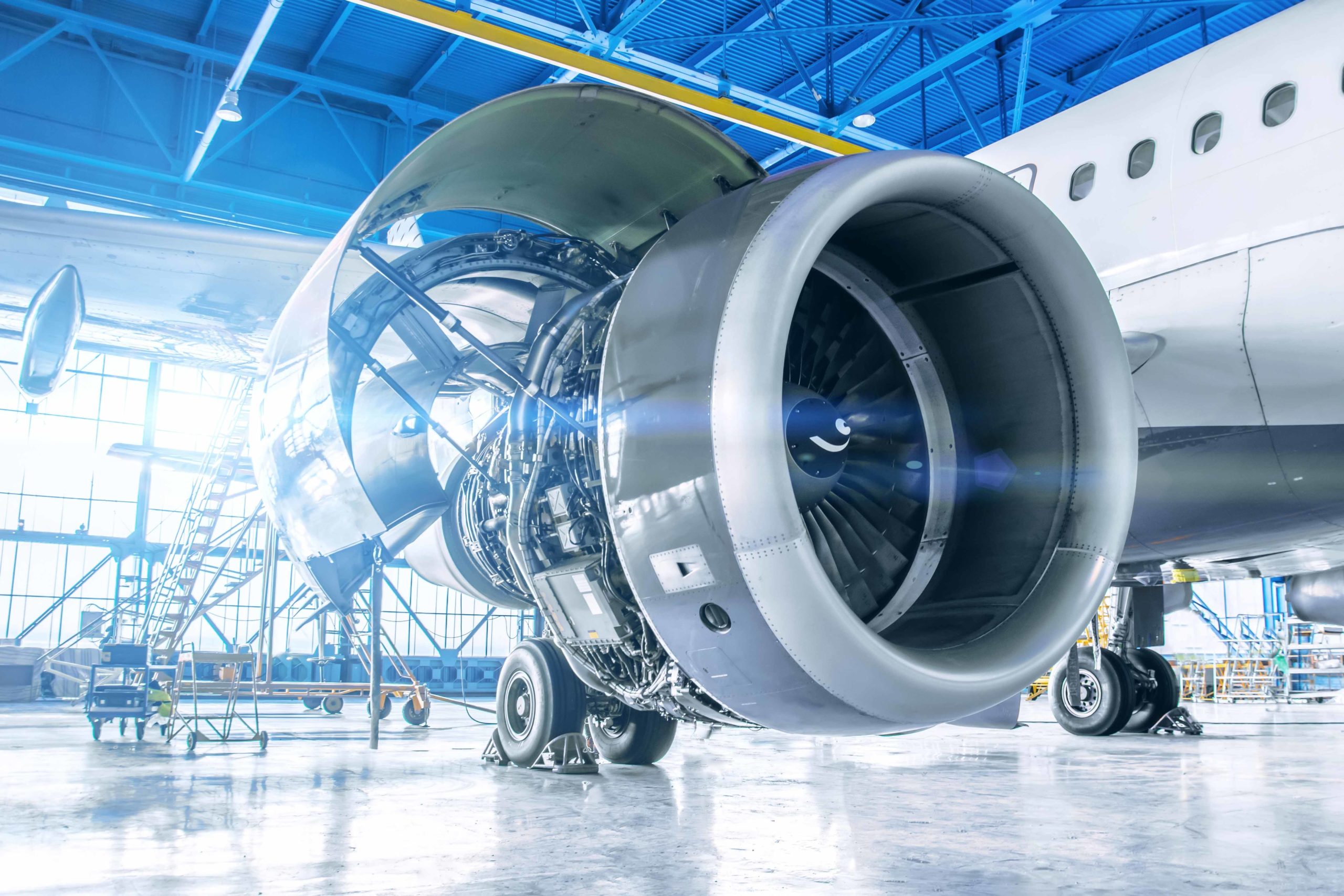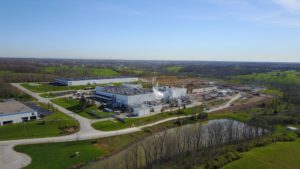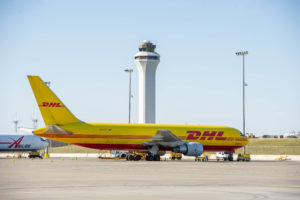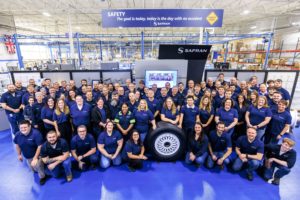The Greater Cincinnati Region: Soaring High as a Global Aerospace Leader

The U.S. aerospace industry is a global powerhouse, boasting one of the largest manufacturing sectors. With air travel demand skyrocketing and exciting advancements in technology promising smoother journeys and more efficient aircraft, the future of commercial and military aviation is brighter than ever. This dynamic sector is projected to reach a value of $525 billion by the end of 2025 and soar to nearly $700 billion by 2030.[i]
Nowhere is this success more evident than in the vibrant Cincinnati region. With Cincinnati/Northern Kentucky International Airport (CVG) ranking as North America’s sixth largest cargo hub, a robust and reliable supply chain and access to a skilled workforce, the region has become a magnet for hundreds of Tier 1 and Tier 2 aerospace suppliers. The region manufactures three times more aerospace products and parts than the national average.
This success story is a testament to the commitment of aerospace leaders. Not only are they proud to call the Cincinnati region home, but they are also dedicated to investing in the future, fostering strong partnerships and engaging with the community to cultivate a skilled workforce ready to shape the future of flight, ensuring the region’s continued success in the aerospace industry.
Establishing a Hub for Aerospace Growth
GE Aerospace, a global leader in commercial and military propulsion, has a long and storied history in the Cincinnati region. February 2024 marked the 75th year of the company’s Evendale, Ohio facility. Constructed in 1941 for the Wright Aeronautical Company’s radial piston engines, the facility enabled GE Aerospace to meet the surging demand for jet engines to power new military aircraft.
“The region has a rich aviation heritage and an equally bright future due to its vibrant aerospace ecosystem and easy accessibility thanks to the nearby international airport,” says Meghan Thurlow, Global Head of Public Affairs for GE Aerospace. “We originally chose Evendale for its proximity to the Wright-Patterson Air Force base and its available manufacturing space left vacant after World War II. The site ultimately became the second production location for our J47 engine, the world’s most produced gas turbine.”
The Korean War significantly boosted J47 demand, with over 35,000 delivered by the end of the 1950s, leading to a ten-fold growth in employment at the Evendale facility. Over the decades, GE Aerospace expanded its jet engine business in the region, powering a range of military aircraft and eventually entering the commercial engine market. Continuous R&D and manufacturing investments have included multiple renovations and expansions of the Evendale facility. Today, GE Aerospace powers three out of four commercial flights, with a fleet of 45,000 commercial engines, and has more than 25,000 engines in service with the U.S. and allied militaries.
After the spin-off of GE’s energy and healthcare divisions, GE Aerospace became an independent, publicly traded entity in April 2024. It now ranks as Cincinnati’s third-largest public company, with more than 9,000 employees across southwest Ohio and northern Kentucky—the single largest concentration of GE Aerospace workers among its 80 global facilities. CEO Larry Culp emphasized the company’s strong commitment to the region, stating, “Why Cincinnati? Why Evendale? When you’re home, you’re home. We’re very comfortable declaring that to the world.”
In the early 1970s, GE Aerospace and Safran Aircraft Engines of France formed the joint venture CFM International to gain a share of the short-to-medium range aircraft market. Considered the most successful joint venture in aviation history and now the world’s leading supplier of jet engines for single-aisle aircraft, CFM International also chose the Cincinnati region for parts of its design, development and production operations. The joint venture recently celebrated the 50th anniversary of its headquarters in West Chester, Ohio, and is fully integrated into GE Aerospace operations. In fact, GE Aerospace dedicates a portion of engineering, development, testing, manufacturing, on-wing support and maintenance and repair operations to supporting the joint venture, including next-generation technology programs such as CFM International’s RISE (Revolutionary Innovation for Sustainable Engines) program. RISE builds on four decades of R&D efforts to make engines cleaner, quieter and more efficient, accelerating the development of more sustainable propulsion technologies that will reduce fuel consumption and CO2 emissions.

Aerial view of Safran Landing Systems Kentucky’s campus in Walton, Kentucky. (Image courtesy of Safran Landing Systems Kentucky)
Safran Landing Systems Kentucky, a leading aircraft landing and braking system producer that is a division of French manufacturer Safran, recently marked its 25th year as a major contributor to the Cincinnati region, producing nearly 140,000 carbon brake disks and over 9,500 wheel and brake sets annually. Beginning modestly with about 50 employees, the company now employs nearly 400 at its state-of-the-art Walton, Kentucky facility, supporting programs ranging from Boeing’s 737/777/787 aircraft to the Airbus A320 family, C-17 and KC-135 military aircraft and serving a customer base that includes UPS, FedEx, United Airlines, Allegiant, Aeromexico, Spirit Airlines and Air Canada.
“In 1998, after winning several contracts to produce carbon brakes for Boeing and the U.S. Airforce, we sought a facility that would allow us to continue expanding in the U.S.,” says Philippe Garnier, Safran Landing Systems Kentucky CEO and General Manager. “Our site selection criteria included the eastern time zone to minimize the time difference with our headquarters in France, an international airport with direct flights to Paris, and reliable and affordable utilities. We also ship and receive across the U.S., so proximity to the airport, large regional shipping companies, and easy access were a huge asset.” While comparable eastern cities like Charlotte, North Carolina, were considered, Garnier says the tax and financial incentives offered by the Commonwealth of Kentucky ultimately tipped the scale.
An Ever-Expanding Aerospace Ecosystem
GE Aerospace, CFM International and Safran Landing Systems certainly helped establish the Cincinnati region as an aerospace hub. Still, they are not the only prominent aerospace companies that have chosen to call the region home. The aerospace sector here has expanded to comprise more than 180 business locations, employ nearly 18,300 workers, and contribute $5.2 billion to the MSA’s gross regional product (GRP). This vibrant ecosystem includes major component and system manufacturers, engineering firms, and service providers like Barnes Aerospace, CTL, Lockheed Martin, Magellan Aerospace, Rhinestahl and StandardAero—many of which have long-standing industry partnerships.

DHL airplane at the Cincinnati/Northern Kentucky International Airport (CVG). (Image courtesy of CVG)
The region continues to attract new companies and support the growth of existing ones, solidifying its position as a hub for aerospace innovation and growth. Recent developments include General Tool Company (GTC), which manufactures aerospace components, purchasing land in Evendale to construct a new 56,000-square-foot advanced manufacturing facility. F&E Aircraft Maintenance recently opened a new $45 million, three-bay hangar at CVG, creating 250 new jobs. DHL Express also broke ground on a new state-of-the-art aviation maintenance facility at the airport, a $292 million investment creating 300 full-time jobs. Quest Defense, a global aerospace and defense engineering services company, has announced plans to expand its regional presence and designate its Cincinnati operations as a center of excellence, nearly doubling its workforce.
Leaders like GE Aerospace also continue to expand in the region. In 2023, the company pledged up to $20 million to support testing hybrid electric engine systems at their Electrical Power Integrated Systems Center (EPISCenter) in Dayton, Ohio. In 2024, they opened a Services Technology Acceleration Center in Springdale, Ohio, and invested more than $127 million in their manufacturing facilities to increase production and improve quality. As recently as January 2025, GE Aerospace announced a massive investment in its Evendale headquarters and Peebles, Ohio, test operation facility, where it will install testing equipment to advance engine technology under the RISE program. With assistance from a $9 million R&D grant from JobsOhio, the latest expansion will create 200 new engineering jobs by the end of 2028.
“Ohio is the birthplace of aviation and the home of innovation for the aviation industry’s future, which was just reinforced by GE Aerospace’s additional investment in research and development in Southwest Ohio,” said JobsOhio President and CEO J.P. Nauseef. “These 200 new jobs will be instrumental in testing and developing more fuel-efficient engines that will power the future of flight, and alongside our partners at REDI Cincinnati, we are proud to have this work being done right here in Ohio.”
Fueled by a Talent-Rich Pipeline
Fueling the success of the Cincinnati region as an aerospace hub is its strong pipeline of talent, something both GE Aerospace and Safran Landing Systems prioritize investing in to maintain their workforce. The region boasts over 3,400 engineering graduates annually, a value that expands to more than 6,000 when considering the Dayton MSA is within Cincinnati’s laborshed. Additionally, the region has a high concentration of skilled manufacturing technicians from several four-year colleges/universities, community and technical colleges, and military service. The University of Cincinnati offers a renowned aerospace engineering program, while Xavier University provides a pathway to a master’s in aerospace engineering for its engineering physics majors. Within the region, Cincinnati State’s aviation maintenance technology program, Butler Tech’s Aviation program, Gateway Community & Technical College’s Advanced Manufacturing Technician Program, and Epic Flight Academy also equip students with in-demand aerospace mechanical skills.
“The local labor market is highly skilled, which supports our advanced manufacturing work. We have strong ties to regional colleges and universities, including donating four CF34 engines to Cincinnati State’s maintenance program. Through the GE Aerospace Foundation and community partnerships, we also invest in regional engineering education and workforce development programs,” says Thurlow, who also serves as President of the GE Aerospace Foundation.
In early 2024, the GE Aerospace Foundation expanded its Next Engineers college-readiness program with the University of Cincinnati, providing hands-on experience to students by working with GE Aerospace engineers. The Foundation also announced a $1 million grant with the United Way of Greater Cincinnati to strengthen collaboration among existing Cincinnati workforce development programs. Furthermore, GE Aerospace partners with Xavier University to provide internship opportunities and support the university’s CAPT Phil H. Bucklew Veteran and Military Family Center, offering long-term career growth opportunities and resources.
Safran Landing Systems, who also selected the greater Cincinnati region in part due to its network of universities and skilled workforce, is equally committed to maintaining the talent needed for the thriving aerospace industry. This is especially vital given the region’s consistently low employment rate compared to the national average, which can make finding labor more challenging.
“We work closely with Gateway Community and Technical College on workforce development, including apprenticeship programs and developing specific courses to address the growing automation in manufacturing,” says Garnier. “At the high school level, we host teacher externships to educate them about manufacturing and bring STEM students to our facility to experience real manufacturing careers. We also collaborate with the Ignite Institute’s Engineering College, providing hands-on training to select students each year.” Located in the northern Kentucky area of the greater Cincinnati region, the Ignite Institute partners with local businesses to develop a cross-disciplinary curriculum and engage students in the engineering process, offering access to dual-credit college classes that enable students to earn an associate’s degree before graduating high school.
Strong Community and Partnerships

GE Aerospace employees serving the Cincinnati region community. (Image courtesy of GE Aerospace)
Maintaining a skilled local workforce is a priority for the greater Cincinnati region’s aerospace companies. However, their positive impact extends beyond talent. By committing to the community and collaborating with local entities, these companies also enhance the lives of residents, improve employee satisfaction and retention and secure vital business resources.
“Helping lift people up in communities where we live and work is part of who we are at GE Aerospace,” says Thurlow. “We support this through our philanthropic efforts that include a range of employee campaigns and volunteer activities surrounding education and workforce development, disaster relief, support for military and veteran families, and community engagement.” GE Aerospace employees, retirees and the GE Aerospace Foundation donate millions of dollars to area programs. In Cincinnati alone, GE Aerospace employees dedicate over 10,000 volunteer hours annually through company-sponsored projects.

Employees at Safran Landing Systems Kentucky. (Image courtesy of Safran Landing Systems Kentucky)
Safran Landing Systems and other regional aerospace companies also actively contribute to the community. Their employees participate in various charitable events and engage in local projects, such as painting fences, cleaning up parks and wrapping gifts for holiday drives. Garnier emphasizes the valuable role of local economic development agencies like REDI Cincinnati, JobsOhio and BE NKY Growth Partnership in creating a competitive business climate and collaborating with regional entities like the Cincinnati USA Regional Chamber, the Port of Greater Cincinnati Development Authority, 3CDC and others that work to ensure the region thrives from the perspective of housing, education, infrastructure and other livability factors. “When I arrived here, my two daughters were very young, and in the past 20 years, I’ve seen the region evolve in a positive way,” he says. “It’s a nice, safe place to raise a family, which we value for all our employees.”
Looking ahead, Safran Landing Systems hopes that local economic development agencies can assist them in achieving their need for green energy and meet their sustainability goal of reducing emissions by 30% by 2030. “These local partners understand our business needs, and we’re fortunate to work with them to identify and submit for available incentives and tax deductions, as well as making sure we connect with the right government and political officials,” says Garnier.
Thurlow echoes this sentiment. “We particularly appreciate strong support from local business partners and economic development organizations. They help create a vibrant community that is attractive for businesses by connecting and engaging local leaders and fostering a friendly business environment,” she says.
[i] US Aerospace and Defense Market Size & Share Analysis – Growth Trends & Forecasts (2025 – 2030)
